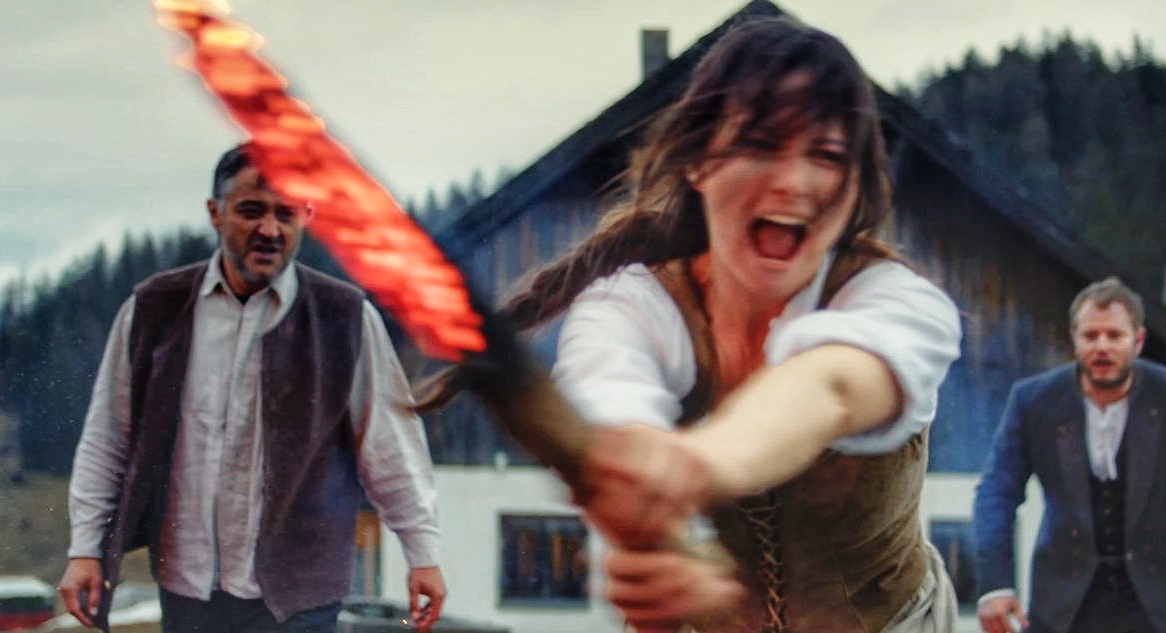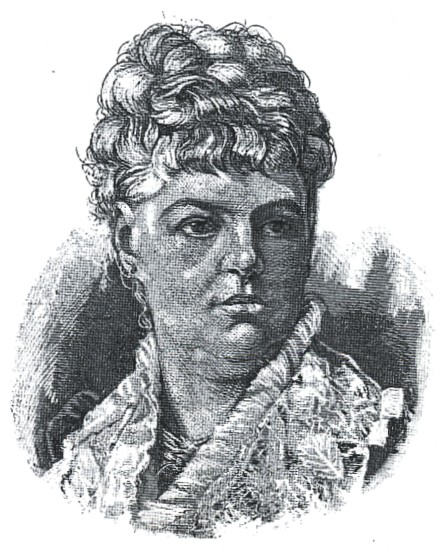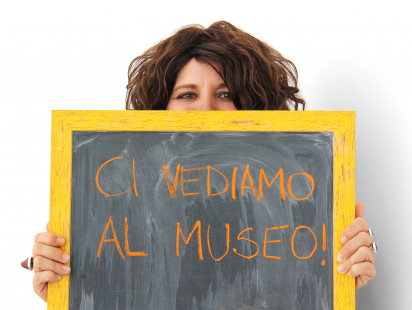
A purely Tyrolean film project aims to shed new light on the novel story of probably the most famous Tyrolean woman. It is about a woman who not only demonstrated unique courage in the second half of the 19th century. She led an extremely self-determined life for the time. Previous films about ‚Geierwally‘ have been based exclusively on the novel by the German writer Wilhelmine von Hillern, in which a freedom-loving girl commits a courageous act, stands up for justice and refuses to let her father interfere in her choice of future husband - only to ultimately submit to her chosen one without any ifs or buts. The real ‚Geierwally‘ would certainly not have done that. I will be following the making of the movie in this blog. In any case, a first short film has already caused quite a stir internationally.
Die Geierwally | Sabrina Engl & Franz Braun (directed by Mario Dengler)
The 'real Geierwally‘ lived as a painter in Innsbruck
Behind the ‚Geierwally‘ is actually an emancipated, courageous and strong woman named Anna Knittel, who was affectionately known as Nanno or Knittele when she was a girl. Born and raised in Elbigenalp in the Lech Valley, 160 years ago she could not be dissuaded from her self-confident female path even as a girl. What many people don't know is that she spent the majority of her life in Innsbruck for the sake of love and the art of painting.
Here, in Maria-Theresien-Straße near Innsbruck's Servite Church, Engelbert Stainer ran an art dealership where his wife Anna sometimes presented her paintings. Such as her self-portrait, which shows her on her dangerous descent to the eyrie with the eaglet. Picture: Stadtarchiv Innsbruck
The heroine of the novel becomes a tragic opera character
What Andreas Hofer is to us Tyroleans as a man, ‚Geierwally‘ is to us as a woman: an original Tyrolean figure of identification. She is unbending, a 'woman's image' with characteristics that were once only tolerated in 'man's images'. The fact that as a young girl she showed the courage to gut two eagles' nests at the same time earned her recognition not only in her home village of Elbigenalp. In the end, she became a famous novel and film heroine. What's more, she even became the central, albeit tragic, character in an opera. ‚La Wally‘ the opera by Alfredo Catalani celebrated true triumphs on the world's stages 30 years after the spectacular deed. The most famous aria from the opera, „Ebben? ... Ne andrò lontana“, was part of the repertoire of the legendary Maria Callas.
Maria Callas, La Wally
The vulture was an eagle, the Wally was a Anna
In real life, Geierwally was called Anna Knittel. The vulture was an eagle, and she was a highly respected painter in Innsbruck, where she spent the majority of her self-determined life alongside the love of her life Engelbert Stainer. It was here that she created her extremely rich oeuvre of portraits, landscapes and floral motifs.
So how did it come about that Anna Stainer-Knittel became the personified epitome of the 'wild and romantic Alps' at the end of the 19th and beginning of the 20th century?
In 1863, when there was no one brave enough to take out an eagle's nest near a mountain pasture in her community of Elbigenalp in the Lech Valley, Anna volunteered, much to the surprise of her father. He was a passionate hunter and gunsmith by trade. He had been trying to shoot an eagle for days, but had constantly 'missed' it. So the eaglet had to be removed from the nest by hand, so to speak, in order to save the lambs from the claws of the pair of eagles and an end as eagle food.
And so, hanging from a hemp rope, Anna abseiled down to the eagle's nest, put the eaglet in a sack and let herself be pulled up again. Her story would normally only have attracted local attention in the valley and among the villagers. We have a Bavarian to thank for the fact that it has become a legend.
Anna Stainer-Knittel has depicted her courageous day in a self-portrait. Dressed in pants, she places the eaglet and the remains of a lamb in a sack she brought with her (click on the picture to see it in full). Image: Wikipedia
A Bavarian 'discovered' the ‚Geierwally‘
In the middle of the 19th century, Ludwig Steub, a trained lawyer and writer, traveled and described the land in the mountains. He wandered through the then still mysterious Tyrol, exploring the valleys, people, customs and traditions of the region. His 'Three summers in Tyrol' and the ‚Tyrolischen Miscellen‘ can now be confidently described as the first impressive travel guide to North and South Tyrol.
Steub's romantically tinged narrative tone, his reports of hard but friendly people and the scenic beauty of the mountains and glaciers had a decisive influence on the image of Tyrol that still prevails today. He should be posthumously awarded a Tyrolean medal.
The Bavarian lawyer and writer Ludwig Steub not only wrote the first 'travel guide' to Tyrol. He is also the real discoverer of the courageous young woman who would later become world-famous as ‚Geierwally‘. Picture: Wikipedia
Before Steub's excursions in Tyrol, only a few strangers had ventured into the mountains as tourists, a world that was still considered 'hostile' at the time, but this changed rapidly. No wonder: Steub literarily transformed the harsh and hostile reality of the Tyrolean mountains into a romantic image of longing, praised the positive qualities of the hard-working people, admired their traditional costumes and completed his first adventurous mountain tours in the Ötztal Alps. Tyrol as a tourist destination was born.
Vent in Ötztal, as Ludwig Steub had experienced it. Such views shaped the romantic image of the Alps. Picture: sagen.at
During his research, Steub learned the story of the girl Anna Knittel for the first time, presumably from a newspaper report. As he knew the art collector and archivist Anton Falger from Elbigenalp in the Lech Valley well, he asked him to motivate the very young girl to write about her deeds.
"The Annele in the Eagle's Nest"
The publication of this unique story first in 'Wolf's Illustrierte Rundschau' and then in the 'Tyrolische Miszellen' under the title "Das Annele im Adlerhorst" was a 'direct hit' with a delay. In it, Anna describes in her own words how she had gutted the Adlerhorst twice. The first time was when she was just 17 years old. In 1863, when she was just 22 years old, she abseiled down the steep 'Saxenwand' to the eyrie for the second time, put the young animal in a bag and was pulled back up by those boys who had not dared to do so in the first place.
The publication of the girl's courageous deed in 'Wolf's Illustrierte Rundschau' in 1864 made Anna known and famous throughout Germany. However, the sitter did not like the depiction at all. She therefore drew a much more beautiful and more colorful depiction. Picture: Wikipedia
The literary sensation
A writer by the name of Wilhelmine von Hillern had certainly read Steub's works very carefully, including the descriptions of Anna Stainer-Knittel. She sensed a perfect, romantic story - a courageous girl falls in love with a bold hunter against her father's firm will. Published in 1875, the novel became a literary sensation and turned the Alps into a kind of place of longing.
The fact that the author then also moved the plot to the Ötztal is further proof that Hillern followed Steub's description. She even went so far as to include real people described by Steub by name in her novel. For example, the pioneer of all mountain guides: Nikodemus Klotz, Rofenhofbauer zu Vent. However, the novel was a huge success.
Play, silent film, heroic film, home movie
Hillern did not hesitate for a second when it came to distilling her novel into a stage play. The theatrical version was published in 1881 and was highly praised by the then famous writer Theodor Fontane.
It is no wonder that the first film about this courageous deed was made in the silent movie era. A second film was made just in time for the Nazis and was shot in 1940 as a kind of German hero film. A third film was made in 1956 and belonged to the category of 'Heimatfilme', which were very popular after the terrible war.
Geierwally, 1956
A short film as the initial spark
The fact that the association's new project ‚Kunstformentirol‘ is leading to a full-length feature film is actually due to an internationally successful short film that the association produced last year. Several awards motivate Mario Dengler as director and Sabrina Engl as the main actress of ‚Geierwally‘, to tell the story anew and in even greater detail. "With respect for the historical figure of this woman, with great appreciation of the wonderful Tyrolean living space and a huge enthusiasm for the cultural and everyday goods of the 19th century," as the film's website states.
Crowdfunding and species conservation
Anyone can contribute to the financing of the historical film set and thus become part of this remake. The journey through 19th century Tyrol will be filmed using authentic props, some of which are true to the original.
With the contributions of many, it will be possible to tell the captivating story of Walburga Stromminger as authentically as possible on the big screen.
20 percent of the crowdfunding for „Geierwally“ will also go towards ongoing European species conservation projects , in which the Innsbruck Alpine Zoo is also involved.
Further information and details can be found here: https://www.startnext.com/geierwally-derfilm
Film sponsorships
Film sponsorships offer companies as well as private individuals the opportunity to participate exclusively in the financing of the film. To the details: https://www.geierwally-derfilm.com/patenschaft
The Geierwally film project online and on social media
You can find the latest information about the film project of the Tyrolean artists' group on the film website https://www.geierwally-derfilm.com/ .
I will tell the 'real' story of Geierwally in a separate 'film blog ' on my blog 'Tirol isch toll': https://tirolischtoll.wordpress.com/geierwally/
My main aim is to portray the social environment of a woman who longed for freedom and justice and was not prepared to submit to today's incomprehensible dictates, which were mostly male at the time. It was also a time when Alpine tourism was practically invented and Tyrol had become a kind of 'destination of longing' for many people. Material for exciting stories.
I am also interested in presenting the artistic work of Anna Stainer-Knittel. Her oeuvre is unjustly overshadowed by her courageous deed, which she herself did not see in such dramatic terms.
Those interested can also follow the progress of the Tyrolean film project on Instagram and Facebook and Facebook.
Rate this article
Show me the location on the map
A volunteer at the "Schule der Alm" alpine farming school, cultural pilgrim, Tyrol aficionado and Innsbruck fan.
Similar articles
Innsbruck is really good at beauty! But where a building site is currently disrupting the…
Innsbruck is a popular tourist destination. The big attraction remains the mountains, but the city has a…
Not just looking at art, but getting to know it better on a guided tour, talking about…
The 'Path of the Senses' from Rietz via Stams to Mötz-Locherboden is an exploration in the…











